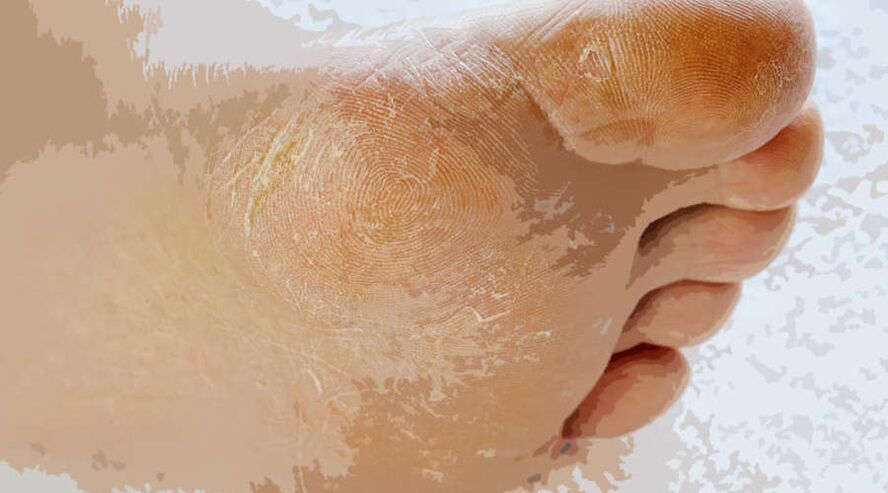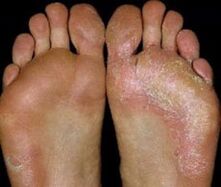
Foot mycosis (ICD code 10 B35. 3) is a fungal infection of the skin of the feet caused by parasitic dermatophytes. It occurs in about 20% of adults. Infection occurs through microtrauma, scratches, abrasions, wounds. Wet feet, diabetes and weakened immunity contribute to the development of the disease.
The prevalence in patients with endocrine disorders and immunodeficiency reaches 50%. More often, the disease occurs in a chronic form, with alternating periods of remission and exacerbation. In 40-50% of cases, it causes foot mycosis onychomycosis or a fungal infection of the nail.
Where and why does the infection occur?
Foot mycosis is an infectious disease that can be easily transmitted by direct contact with a fungal carrier or household items. For example, shoes, socks, towels, manicure supplies, rubber mats in the shower. In 70-95% of cases, the causative agent of foot mycosis is Trichophyton red (Tr. Rubrum).
Infection usually occurs in high humidity public places where there are favorable conditions for the pathogen to multiply and spread. Such places: swimming pools, public showers, saunas, water parks, gym locker rooms. If a fungus-infected person walks barefoot on the floor or carpet in the shower, it leaves infectious particles behind. And then if a healthy person enters this place barefoot, the pathogen falls on his skin. In this case, the fungus does not always manifest immediately and causes the characteristic symptoms of the disease. With strong immunity, in the absence of health problems, a person simply remains a carrier of the infection, yet does not get sick.
The risk of developing fungi and mycosis of the foot increases:
- damage to skin integrity;
- Violation of the blood supply to the limbs, which impairs the supply of oxygen and nutrients to the tissues, slows down the regeneration process and weakens the local immunity;
- diabetes mellitus, high blood sugar creates favorable conditions for the growth of the fungus, the progression of the infection;
- excessive sweating;
- dry skin that leads to microcracks;
- old age;
- blood diseases;
- long-term use of antibiotics, immunosuppressive drugs;
- vitamin deficiency;
- Wear shoes that are impervious to air and create a "greenhouse effect. "
Symptoms and types of the disease

Mycoses of the foot occur in different ways, the type of pathogen and the severity of the lesion affect the symptoms. The first signs of the disease appear in the folds between the fingers and spread from there to the soles of the feet, the sides, the back and the nails.
The photo shows what the legs look like in mycosis.
If the nails become infected, thicken, gloss loss and blurring of the disc can be observed. The nail acquires a yellow to gray hue, becomes brittle, crumbles.
Early clinical signs of foot mycosis include dryness, peeling skin, and painless cracks in the folds between the toes. This form of the disease is called erasure. Peeling and cracking do not cause pain, itching or discomfort at first. Only a doctor can detect the first undeclared signs of a fungal infection. In addition to the deleted one, other clinical forms of foot mycosis are distinguished, each of which has its own symptoms.
Squamous
In the scaly form of foot mycosis, exfoliation occurs between the toes and in the lateral wrinkles. There are usually no signs of inflammation. Possible redness, damage to the nails, itching, thickening of the stratum corneum, which gives light to the skin. Papillary lines become more pronounced, the surface of the skin dries out, and is covered with lamellar scales. In this case, the patient does not feel itching or other discomfort.
Hyperkeratic
Appears as a rash on vaults. The surface of the rash elements is covered with gray-white layered scales. There is a detachment of the epidermis from a single bladder. When fused together, the rashes form hazy large foci that spread throughout the sole, including the lateral, posterior surfaces. Along with the foci of exfoliation, there are areas of hyperkeratosis or thickening of the skin. They look like calluses, with cracks on the top. With the hyperkeratotic form of foot mycosis, the affected area is similar to the manifestations of psoriasis or eczema. A person worries about dryness, itching, and sometimes pain.
Intertriginous
The intertriginous form of leg mycosis is similar to the symptoms of a diaper rash. Hence the name lat. intertrigo - "diaper rash". More often, the skin is touched at intervals between the third and fourth, fourth, and fifth fingers. It will be bright red, edematous. Crying wounds, deep, painful cracks occur. In contrast to diaper rash, lesions of intertriginous mycosis are round, with light outlines, separated by a white outline between the edges of the epidermis. The person experiences itching, burning, pain.
Dyshidrotic
Dyshydrotic forms of leg mycosis are characterized by several thick-pointed vesicles located mainly on the arches. The rash spreads to large areas of the sole as well as the spaces between the toes and the skin of the toes. Combined to form large bubbles. Wet erosion appears at the site of the bursting bubble. As the inflammation increases, the skin turns red and swells. During the bladder formation stage, the patient feels unbearable itching.
Diagnosis
If you suspect foot mycosis, you should see a dermatologist. To confirm the diagnosis, the doctor examines the legs, asks what symptoms bother the person, how long and after they appeared. Take a scrape from the affected area for microscopic analysis, cultural research to identify a specific pathogen type. In addition, your doctor may order blood tests.
How do we treat foot mycosis?
Mycologist or dermatologist deals with the treatment of mycosis of the skin of the foot. Taking into account the clinical form of the disease, the severity of the lesion, the visible changes, the doctor chooses the appropriate therapy.
Complications of a mycotic infection on the feet can lead to a fungal infection of the hands. Foot mycosis sometimes leads to secondary bacterial infections, especially if there are crying sores on the skin.
External fungicides (ointments, creams) and tablets for oral administration are prescribed to control the fungus. Only topical therapy is effective in milder forms of foot mycosis. According to clinical guidelines, oral medications are prescribed in severe cases.
If necessary, the treatment is supplemented with anti-inflammatory, desiccant, antiseptic, anti-allergic drugs, agents that enhance the regeneration of damaged tissues. If there are signs of bacterial infection, antibiotic therapy is prescribed.
In case of onnychomycosis, we perform hardware cleaning of the areas infected with the fungus. For the subsequent processing of the nails, local antifungal agents are prescribed: varnish, cream or ointment.
The duration of treatment is from two weeks to one month. If not only the skin but also the nails are affected, treatment is delayed. This is due to the nail growing slowly. To get rid of the infection, a completely healthy nail plate needs to grow back.
Mycosis can be successfully treated if your doctor prescribes it. But if, noticing the improvement, the patient stops taking the medication, it leads to a recurrence of the infection, a transition to a chronic form. It is necessary to complete the entire course of treatment, even if the symptoms of the disease have disappeared.
It is very important in the treatment of foot mycosis foot care, personal hygiene, diet, selection of comfortable shoes that do not damage the affected areas.
What should I do to prevent it?
To prevent or reduce the risk of mycosis of the legs and nails, the following recommendations will help: or the body's defenses are reduced;
If you notice a slight peeling on your feet, even on the skin, or cracks between your toes, you may want to do a fungus check. Early diagnosis and timely treatment will help avoid complications, extensive damage, discomfort, pain while walking, and bacterial infection.






























